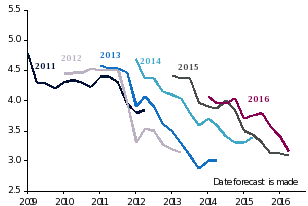The International Monetary Fund (IMF) released its bi-annual survey of the global economy last week. As has been customary in recent years, the outlook for global growth has been revised down. The IMF now expects the global economy to grow by 3.2% in 2016, down from the 3.4% forecast made in January. The IMF has cited the loss of growth momentum in advanced economies, the perception of monetary policy impotence, the turbulence in financial markets and political and natural forces as reasons behind the downgrade. If the world indeed grows by 3.2% this year, it will represent only a marginal improvement over the weak 3.1% growth recorded last year.
The IMF has revised down its forecast for global growth in 2016 for the fourth consecutive year. Since 2013, the IMF’s early optimism has been checked by concrete reality. Between January and April of each year, the IMF has revised down its growth forecast for that year by 0.15% on average. Each year seems to begin with hopes that past crises are behind us and that recovery will take a firm hold, only for growth to eventually disappoint. The recovery has been “too slow for too long” as the IMF report was titled.
IMF global growth forecast revisions

Sources: IMF and QNB Economics
What has the led the IMF to revise down its forecast by 0.2% in the last three months? Four factors were behind the revision, which was broad-based, covering both advanced economies and emerging markets (EMs). First, growth momentum in advanced economies seems to have weakened. This is particularly the case in the US, where growth in the fourth quarter of 2015 fell to 1.4% from an average of 3.0% in the previous two quarters. The subdued growth seems to have continued into the first quarter of this year, where consensus forecast stands at 1.2%, according to Bloomberg.
Second, there is a perception that policymakers are running out of ammunition to stimulate the economy. The euro area and Japan provide the clearest examples. In both regions, an aggressive easing of monetary policy, including the use of negative interest rates, led to a strengthening rather than a weakening of their currencies. This counterintuitive development may suggest that financial markets are losing faith in central banks’ abilities to provide stimulus in the face of an adverse growth shock.
Third, oil prices have fallen sharply in the early part of the year as risk sentiment in financial markets has waned. While lower oil prices should benefit oil importers as much as it hurts global exporters, the symmetry seems broken. This could be due to differences in the reaction time to the shock. While the loss of income for oil producers leads to immediate spending cuts, the gains for oil importers in the form of higher consumption seem to materialize only slowly.
Fourth, non-economic factors have had adverse effects on the global economy. These include political forces such as the uncertainty about the outcome of the US presidential elections and the potential exit of the UK from the European Union. There are also security concerns over terrorists attacks and regional civil wars. Finally, the extreme flooding and drought caused by El Nino has impacted the economies of many regions.
Is the IMF’s new growth forecast of 3.2% realistic? On balance, it seems reasonable, although there are reasons for both pessimism and optimism. On the negative side, there is the risk of further financial market turmoil, possibly triggered by a premature policy tightening in the US, especially given the perception of impotent central banks elsewhere. There is also the risk that China’s ongoing transition away from investments and towards consumption might cause hiccups in the global economy given China’s size, contribution to global growth, dominance in global trade and importance for commodity markets. Finally, the risk of capital flight from EM remains elevated, given potentially tighter monetary policy in the US and high foreign currency debt in EMs.
On the positive side, the IMF’s forecast of oil prices (USD34.8 per barrel in 2016) seems too pessimistic. This was presumably based on futures prices, which are quite volatile and move in line with spot prices. Indeed, the futures market has moved quite aggressively since the IMF wrote the report, and now points to an average oil price of USD42.0 per barrel in 2016. This is close to our forecast of USD40.8, which combines demand and supply analysis together with the information contained in consensus forecasts and futures prices.
Overall, the uncertainty cloud still hangs over the global economy, and its unimpressive recovery is probably going to continue to stutter along.
